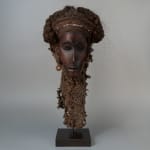Chokwe Pwo Mask, 20th Century CE
Wood, shells, fibers
20 x 12 cm
7 7/8 x 4 3/4 in
7 7/8 x 4 3/4 in
ES.6694
Further images
The Chokwe live in an area that straddles the nations of Zambia, Congo and Angola. Seemingly descended from several pygmy tribes, they were incorporated into the Lunda Empire during the...
The Chokwe live in an area that straddles the nations of Zambia, Congo and Angola. Seemingly descended from several pygmy tribes, they were incorporated into the Lunda Empire during the 18th century but later achieved independence and refused to pay tribute to the Lunda emperor. Their strategic location (for trading) and access to raw materials such as ivory and rubber led to burgeoning wealth and political influence that was essentially unchallenged until the early 20th century when the European thalassocracies – notably Portugal – brought an end to Chokwe dominance of the area.
This mask is designed to represent the ideal woman in a series of mukanda (circumcision) initiation ceremonies. She is either Pwevo (or Pwo) – meaning a fulfilled woman – or an adolescent woman on the verge of adulthood, dubbed Mwana Pwevo (or Mwana Pwo). The circumcision rituals are incomplete without this character, who is escorted with great pomp and circumstance to the chief of the village, and then demonstrates all womanly virtues while coordinating music, dancing and other aspects of the ceremonies. She will also dance, usually in an erotically-charged manner, to emphasise fertility, fecundity and sensuality, the positive aspects of achieving social maturity. She also demonstrates her otherworldly status as a spirit by acrobatic displays, or stilt walking. The dancer is always male; the woman of the village have the right to attack or otherwise dismiss a substandard performer if they feel that he is not painting womanhood in an appropriate light. They are also told a secret name for the dancer – who they are not supposed to be able to identify, the mukanda ceremony being an exclusively male preserve – which they can use to request the return of a favoured performer. The Pwevo performer marks a bridge between the boy’s mothers and their mukanda status, and thus occupies a very important role within the society. This mask reflects this importance, and is also an extremely refined and perfectly-executed example. The body is made from a dark wood with a marked patina. The face is tall, with a rounded brow tapering symmetrically to a pointed jaw, and surmounted by a band of hatched design denoting a headband, or hair. The eyes are slitted, with high arched brows and a slim, tapered nose. The whole is surmounted by a band of cowrie shells and a knotted rope head-dress, which gives way to a net arrangement designed to fit over the head of the dancer and thus disguise his identity.
This mask is designed to represent the ideal woman in a series of mukanda (circumcision) initiation ceremonies. She is either Pwevo (or Pwo) – meaning a fulfilled woman – or an adolescent woman on the verge of adulthood, dubbed Mwana Pwevo (or Mwana Pwo). The circumcision rituals are incomplete without this character, who is escorted with great pomp and circumstance to the chief of the village, and then demonstrates all womanly virtues while coordinating music, dancing and other aspects of the ceremonies. She will also dance, usually in an erotically-charged manner, to emphasise fertility, fecundity and sensuality, the positive aspects of achieving social maturity. She also demonstrates her otherworldly status as a spirit by acrobatic displays, or stilt walking. The dancer is always male; the woman of the village have the right to attack or otherwise dismiss a substandard performer if they feel that he is not painting womanhood in an appropriate light. They are also told a secret name for the dancer – who they are not supposed to be able to identify, the mukanda ceremony being an exclusively male preserve – which they can use to request the return of a favoured performer. The Pwevo performer marks a bridge between the boy’s mothers and their mukanda status, and thus occupies a very important role within the society. This mask reflects this importance, and is also an extremely refined and perfectly-executed example. The body is made from a dark wood with a marked patina. The face is tall, with a rounded brow tapering symmetrically to a pointed jaw, and surmounted by a band of hatched design denoting a headband, or hair. The eyes are slitted, with high arched brows and a slim, tapered nose. The whole is surmounted by a band of cowrie shells and a knotted rope head-dress, which gives way to a net arrangement designed to fit over the head of the dancer and thus disguise his identity.







